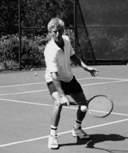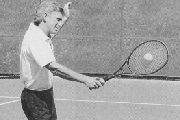|
TennisOne Lessons
All Volleys Are Not Equalby Jack W. BroudyMost players are taught to "punch" volley from the time they are a beginner until they are an "A" player. What does that mean--punch? Is it the same punch for the forehand as for the backhand? Does the volley actually look like you're punching someone? That would indicate that you bring your elbow from a bent (and tight) position to a straight one. I don't see too many pros that have that abrupt (or ugly) of a stroke. Plus, I notice most club players that try to use the punch" volley, hit the ball back into the center of the court--constantly.
Balls that are hit close to your body are handled the same way; however, your arm cannot be straight, and therefore you use your elbow the way you used your shoulder--keep your elbow tight to your body and bang the back of your arm to the net using your elbow only. Try to stop at the contact point and not bring your arm across your body. It's unnecessary and it can facilitate mis-hitting. Your racquet face (and the back of your hitting hand) should face the court, as much as possible throughout the stroke. Should you have trouble "locking" the racquet head in place, try squeezing (with a firm wrist) your racquet grip on contact. Also very often it helps to think about bringing the racquet head slightly around the ball, catching a piece of the "outside" of the ball. That usually helps to firm up the wrist, thus producing a more solid volley. In any case, stop relying on "punching" your volleys to become a better volleyer. There's almost no validity to that method. Play well. Send email to the author We encourage you to email your comments (pro, con, appreciative, whatever) directly to the author. To send email to Jack Broudy, click here. Jack Broudy, author of "The Real Spin on Tennis," is a teaching pro at The Bobby Riggs Tennis Club. For information on Lessons, Clinics, Summer Tennis Camps and The Bobby Riggs Tennis Academy call (760) 753-4705.
Back to TennisONE Home Page webmaster@tennisone.com
|

